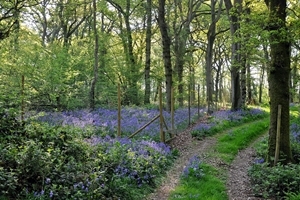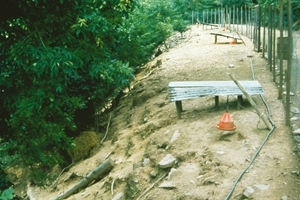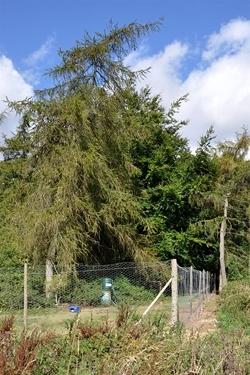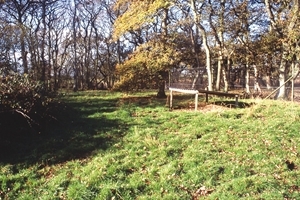Key points
- Pheasant releasing into open-topped woodland pens is common across the UK.
- This alters soil chemistry, increases soil disturbance and the amount of bare ground, and affects plants that grow within the release pen.
- The other management carried out to benefit pheasants, such as opening the forest canopy to allow light into the woods, is known to be good for other wildlife such as butterflies, bees and songbirds.
- It is not known how long the negative effects of releasing last, or whether or when the pen areas recover once they are no longer used.
- This study compared disused release pens with reference areas that had not housed release pens to study the differences and recovery.
- Some of the changes seen in release pens persisted for many years after disuse.
- After ten years, pens that had held pheasants at below 1,000 birds per hectare showed signs of recovery. Pens that held pheasants at higher densities had not recovered by 20 years, and it appeared that those with the highest densities continued to worsen for some time after disuse.
- Moving pheasant release pens around to different locations within the same wood will result in more of the wood being affected. To reduce the impact of pheasants on woodland ground flora and soils, we recommend that game managers follow GWCT science-based guidelines on stocking densities and only move release pens where necessary.
Background
 Driven pheasant shooting is popular in the UK, but the number of wild gamebirds cannot support the demand, so most shoots rely on birds that are reared and released. Young birds are released into open-topped pens in woodland in the summer and spend several weeks acclimatising to the habitat before the shooting season begins in October. During this time, they gradually disperse from the release pen into the surrounding countryside, usually returning at night to roost. Somewhere in the region of 40 million young birds are thought to be released each year, and many woodlands support these birds, so it is important to understand the effect of this large-scale release on the environment.
Driven pheasant shooting is popular in the UK, but the number of wild gamebirds cannot support the demand, so most shoots rely on birds that are reared and released. Young birds are released into open-topped pens in woodland in the summer and spend several weeks acclimatising to the habitat before the shooting season begins in October. During this time, they gradually disperse from the release pen into the surrounding countryside, usually returning at night to roost. Somewhere in the region of 40 million young birds are thought to be released each year, and many woodlands support these birds, so it is important to understand the effect of this large-scale release on the environment.
Previous research has shown that the woodland management for game birds, including coppicing, maintaining glades and clearings, rides and hedges, and planting game crops, has many advantages for other wildlife. Songbirds and butterflies are known to thrive in woodland managed for pheasants.
 However, within the release pen itself, we know that there are negative effects on the plant communities that grow there; there is more bare ground, and there are more nutrients in the soil than in areas that do not house release pens. The kind of plants that grow in release pens changes for several reasons: the birds’ droppings add nutrients to the soil, their pecking and scratching disturbs the ground, and management of the woodland canopy allows more light in.
However, within the release pen itself, we know that there are negative effects on the plant communities that grow there; there is more bare ground, and there are more nutrients in the soil than in areas that do not house release pens. The kind of plants that grow in release pens changes for several reasons: the birds’ droppings add nutrients to the soil, their pecking and scratching disturbs the ground, and management of the woodland canopy allows more light in.
Jointly, these factors often mean fewer of the rare woodland plants that are found naturally in undisturbed woodland, and more plants such as nettles, which thrive with more light and nutrients. These changes are confined to the pen itself, but the wider benefits brought by the other management are felt across the whole woodland. For this reason, it is recommended that release pens take up a third or less of any woodland so most of the wood isn’t penned. This maximises the benefits to the wider area, and it reduces the area which is negatively affected.
Although the effects of release pens have been well researched, it is not known whether, or how quickly, the areas can recover if the pen is no longer used. This is important because pens are sometimes moved around and re-sited in other areas within the same woodland to reduce the likelihood of disease or for other reasons related to shoot management.
What they did
 GWCT scientists studied sites that had previously been used as release pens for between 10 and 20 years, for which good records were held, but which had not been used as such for at least three years. 65 of these sites were identified in woodland across Berkshire, Dorset, Hampshire, Sussex and Wiltshire, and for each of the disused pens a reference, or ‘control’ site was identified. These control sites were located in the same piece of woodland and were similar in size and shape but had not been previously used as a pen. They were away from the pen itself, and from areas where pheasants tend to gather.
GWCT scientists studied sites that had previously been used as release pens for between 10 and 20 years, for which good records were held, but which had not been used as such for at least three years. 65 of these sites were identified in woodland across Berkshire, Dorset, Hampshire, Sussex and Wiltshire, and for each of the disused pens a reference, or ‘control’ site was identified. These control sites were located in the same piece of woodland and were similar in size and shape but had not been previously used as a pen. They were away from the pen itself, and from areas where pheasants tend to gather.
At each pen and its control pair, the plants were surveyed at ten points within the site. These vegetation surveys were carried out between April and July of 2006, 2008 and 2011, and they recorded the amount of bare ground, percentage of ground covered by each plant species, and the vegetation cover between ground level and up to 2m in height. Soil samples were also taken at each site visited in 2006 and 2011, three from each site. These were analysed for their organic matter content, their acidity (pH), and their fertility by measuring nitrate, phosphate and potassium content.
All these measurements were examined to identify any differences between the disused pens and their control sites, considering how long it had been since the pen was used, as well as the typical stocking density when birds were in the pens.
What they found
Some of the differences that are known to occur when pheasants are in the pens were found to persist for many years after pens are no longer used. In particular, there are fewer ancient woodland indicator species in disused pens compared to control areas, and there are fewer plant species overall found in old release pens compared to areas that have not been used as pens. Plants including yellow archangel, bluebells, wood avens and ivy species were less frequent at release pen sites. Species that prefer to grow where soil nutrients are higher, such as nettles and wild garlic, covered more of the ground in release pens compared to control sites.
In pens with low stocking densities (under 1,000 per hectare), the number of ancient woodland species recovered with time, but this recovery took approximately ten years. For pens which had very high stocking densities (over 2,000 birds per hectare) there were no signs of recovery, even in pens that had been disused for longer.
Soil samples showed that phosphate and potassium levels were higher in release pen than control sites, and that these changes persisted after pens were disused, but that levels of nitrate, pH and organic matter were no different.
What does this mean?
 This study showed that the differences in soil chemistry and plant species that are known to occur in pheasant release pens continue to affect the area after pheasant release is no longer carried out. Where the density of released birds was low, woodland plants can recover after around ten years, but for those which stocked with higher densities, the changes persisted even in pens that had not been used for over 15 years.
This study showed that the differences in soil chemistry and plant species that are known to occur in pheasant release pens continue to affect the area after pheasant release is no longer carried out. Where the density of released birds was low, woodland plants can recover after around ten years, but for those which stocked with higher densities, the changes persisted even in pens that had not been used for over 15 years.
Knowing that the woodland takes many years to recover sheds new light on the practice of moving pheasant release pens. As old sites do not recover quickly, and new sites will be affected as well, the total area of woodland potentially damaged by pheasants will be higher if pens are moved. Although this is a technique sometimes used to reduce the likelihood of disease in gamebirds, particularly parasites, we recommend using different approaches, such as lowering stocking densities or moving feeders. The GWCT’s Advisory service recommends limiting pheasant release density to 1,000 birds per hectare (700 in ancient semi-natural woodland) to minimise negative impacts on woodland flora, and adhering to these densities will also help with disease control.
Read the original abstract
Capstick, L.A., Sage, R.B., & Hoodless, A. (2019). Ground flora recovery in disused pheasant pens is limited and affected by pheasant release density. Biological Conservation, 231: 181-188.